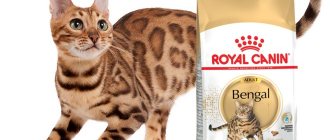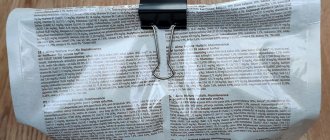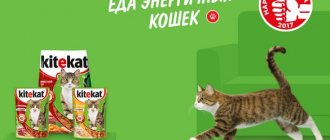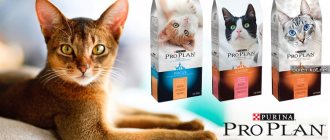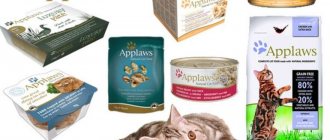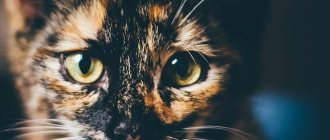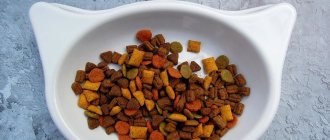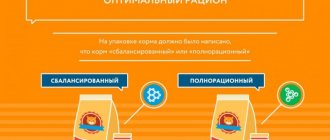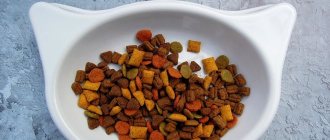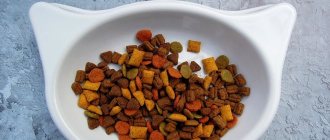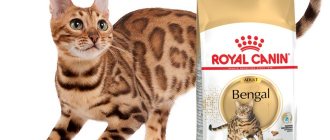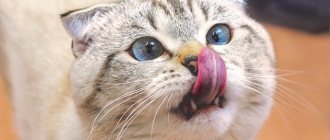First of all, let us clarify that by mixing food we do not mean giving pets a temporary treat, but regularly adding wet canned food to the main, dry type of diet. Moreover, the volume of the latter can range from 30 to 50% or more of the total daily norm - for example, a whole jar or 1-2 pouches.
Let's start with the messages that guide animal owners when choosing a mixed type of feeding:
- dry food in itself is harmful, and for the health of the pet it is advisable to dilute it with something useful;
- the animal does not like to drink water, and canned food somehow provides moisture;
- I want to diversify my pet’s menu and pamper it;
- dry without wet animals ignore.
Despite the fact that each of the above reasons can be objected to, and in some cases the issue can be resolved by adjusting the pet’s behavior, experts have no scientific counter-arguments against combined feeding.
In fact, there is no particular difference between dehydrated granules and wet kibble, which are identical in composition, except, of course, the presence of moisture. Both types of food are complete, that is, they can contain vital nutrients for cats and dogs in the right ratio. Both are well eaten and digested by pets, however, with a mixed feeding scheme, many factors must be taken into account, which we will discuss below.
Features of different types of food, pros and cons
Some cat owners believe that wet food contains more nutrients than dry food. Experts say that the composition of different products of the same brand is practically the same.
Dry ready-made food
Dry food from different manufacturers varies in composition. The quality of the product also depends on its class: economy, premium, super-premium and holistic.
Veterinarians do not recommend that cat owners purchase low-quality food that belongs to the economy class. This product contains very few natural ingredients and the animal does not benefit from it. Veterinarians recommend using premium or super-premium food as the main diet. Their composition is correctly balanced. These granules are made from quality products. They include fish, meat, vegetables, cereals, vitamins, macro- and microelements.
Holistic cats are usually purchased by breeders of pedigree cats who breed purebred animals for sale. High-quality dry food is also purchased for pets suffering from chronic diseases. Manufacturers of holistic products produce a variety of lines that take into account the needs of all categories of animals: kittens, adult and elderly pets, sick, castrated and sterilized.
The only drawback of dry granules is the low percentage of liquid content, so the animal needs constant unhindered access to fresh water. Among the advantages of high-quality dry food are:
- efficiency;
- possibility of long-term storage;
- nutritional value and presence of vitamins.
Wet (canned) food, pates and soufflés
The composition of wet food is identical to dry granules if they are produced by the same brand and belong to a single line. The difference between canned food and spiders from granules is the volume of liquid they contain. Wet types of products for cats contain about 70% moisture, dry types - no more than 7%.
Pets like canned food more than dry food. Cats are attracted to the delicious-smelling sauce or jelly, the consistency of the pieces and pates. This type of food is convenient to eat. However, veterinarians do not recommend feeding cats exclusively with it for a number of reasons:
- wet food does not provide long-term satiety, so animals constantly feel hungry and ask for additional portions, which leads to overeating and weight gain;
- soft food does not provide the necessary stress to the animal’s teeth and jaws, resulting in dental and gum disease;
- pieces are quickly digested in the stomach, which disrupts the digestive system of predators and can disrupt the functioning of the pancreas.
Natural products
Despite all the obvious advantages of natural food, it cannot be called absolutely healthy. To prepare quality food for your pet, you need more than just good ingredients. The owner must know what ratio of proteins, fats, carbohydrates, mineral components and vitamins the cat needs daily.
Dishes for the animal must be prepared taking into account the characteristics of the body. The food should contain boiled meat, fish or poultry, fermented milk products, and vegetables. When feeding your pets natural products, you must follow the following rules:
- Do not use raw meat and fish. Meat products that have not undergone heat treatment may be contaminated with parasites. Helminth larvae enter the animal's body with food and begin to multiply.
- Do not feed the same type of protein foods. Some owners prepare food for cats exclusively from fish. This diet negatively affects the condition of the liver and kidneys. Excess meat on the menu leads to a decrease in the amount of calcium in the body, and the animal’s bones become brittle.
- Do not feed undercooked or tubular bones. Cartilage, spongy bones, and chicken necks are rich in nutrients, but they must first be boiled well. Salmonella, E. coli and other pathogens can live in bones. Tubular bones often cause injuries to the mucous membrane of the gastrointestinal tract.
Kitten food
Some veterinarians believe that commercial food is better than natural food. The fact is that when developing a recipe, nutritionists take into account the needs of a small organism. Kitten food already combines nutrients, vitamins and minerals in the right proportions. Many manufacturing companies specializing in pet food produce “baby food”:
- special milk formulas (milk substitutes) from 0 months;
- wet food from 1 month;
- dry food from 2 months.
A sudden switch to dry food can lead to digestive problems
Some manufacturers offer customers dry food 1+, but this is not entirely correct. Even if the packaging says that such food is intended for a kitten from 1 month, you should not be happy about it. The basis of the baby’s diet should still be soft food. Therefore, even if you decide to accustom your cat to such solid food, you should give it no more than 2 times a day, and everything else should be soft. And, of course, you need to remember a few rules related to ready-made food:
- With this diet, no vitamin supplements are needed (the food already contains everything you need).
- If it seems to you that the kitten is not getting enough to eat, then you can grow (or buy) special grass for cats.
- Wet and dry food (if combined) should be of only one brand (ideally from the same series).
- You should not give your baby as much food as indicated on the package (kittens need about 4/5 of the amount recommended by manufacturers).
Dry and wet food
There are two types of wet food for kittens - pouches (bags) and canned food. The main difference between them is the length of shelf life (food in cans lasts longer). Wet food contains a lot of liquid, while dry food contains only 5-12% moisture. But dry food lasts longer than wet food. However, when feeding a kitten with dry food, you need to observe a special drinking regime.
If your kitten eats dry food, he should drink a lot. There should always be a bowl of clean, fresh water next to your food. The cat will not drink excess liquid, so there should always be water. It needs to be replaced daily with a fresh one (even if it seems that the kitten is not drinking).
When feeding with dry food, the kitten needs to drink a lot
Wet food can be introduced into the menu faster than dry food. The liquid consistency (for example, pate for kittens) is designed in such a way that the transition to such food is almost unnoticeable. And you need to switch to dry food gradually. When I introduced my kitten to dry food, on the first day it was just a few granules - I soaked them in water. For a few more days I soaked a teaspoon of food in water. It took us about 3 weeks to completely switch to dry food.
Important: ready-made food for kittens must be of the highest class. Veterinarians recommend super premium and holistic foods to their young patients. Budget options (for example, Whiskas or Kitiket) are strictly criticized. Not only its price, but also its composition and quality depend on the class of the product.
High-quality kitten food includes products from the following brands:
- Hills, Chicken Soup, Almo Nature (wet and dry food);
- Bozita, Petreet, Gourmet (wet food);
- Eukanuba, Eagle Pack, Royal Canin, Brit (dry food);
- Iams, Pro Plan, 1st Choice (canned and dry food);
- Merrick, Gimpet, Felidae (wet food);
- Innova, Bocsh, Pro Nature, Acana (dry food).
Photo gallery: examples of quality food for kittens
"Fest Choice" is a Canadian brand food (packaging: 350 g, 907 g, 2.72 kg and 10 kg)
"Sanabel" belongs to the premium and super premium class feeds Eucanuba is not inferior in quality to other feeds, but is cheaper
Gimpet offers customers not only wet food for kittens, but also special treats
They claim that their food does not contain dyes or preservatives
How to choose ready-made food
The opinions of veterinarians about the age suitable for introducing ready-made food into the diet are divided. Some believe that kittens should not be fed commercial food until they are 3 months old. Others believe that a kitten can be fed such food even from birth. Particularly vivid discussions arise about dry food. Those veterinarians who allow their charges the so-called drying process believe that special food is produced for kittens. The granules in it are small, and the composition is specially designed for the healthy development of the baby. However, kitten owners follow the manufacturers' recommendations. Some people simply choose a pack that has the appropriate age on it. But when choosing this product, you need to consider other factors:
- Natural ingredients (in the composition of the feed they should prevail over artificial ones: meat, offal, plant raw materials, etc.).
- The more meat in a product, the better (meat and a product of processed raw materials of animal origin are not the same thing).
- There should be a minimum amount of dyes, preservatives and flavors (ideally, when there are none at all).
- Expiration date (it should expire tomorrow, in a week, etc.).
- Packaging volume.
Of course, buying, for example, 85 g pouches every day is inconvenient. Buying them in a whole package at once is unprofitable, and they will spoil quickly. Dry food in large packages can spoil (moisture, bacteria, etc.). I try to buy medium-sized packages. If I need dry food, then I choose bags or boxes of 0.4–1 kg. Canned food is more convenient in cans, for example, 195 g. Otherwise, everything depends on the brand of food. Some manufacturers produce a suitable product in only one form, in which case the cat owner will have to go to the store more often.
Before purchasing kitten food, carefully read the packaging.
Is it possible to feed a kitten cat food?
The age at which you need to switch from baby food to adult food depends on several factors:
- Type of food. With natural nutrition, this transition occurs smoothly and imperceptibly.
- Type of feed. Commercial baby food is designed for kittens of a specific age.
- Kitten health. The veterinarian may recommend a certain diet, etc.
Typically, kittens reach the size of an adult cat at about 7–8 months, but until the age of 1 year the animal is still considered a kitten. I bought my cat spiders that said “0–12.” The cat is just over a year old, but she still doesn’t refuse soft baby pies. True, now it’s just a delicacy, and not the main food. I know a person who allows his kitten to eat dry food for an adult cat. He says that he feels sorry for the kitten who eats the same thing all the time, and sometimes he really wants to pamper the baby.
If a kitten lives with an adult cat, then it may have access to a bowl of adult food. Nothing bad will happen if a cat (for example, at the age of 2-3 months) tries a couple of pieces. But you should not constantly feed your baby such food. Special food for small kittens is different from food for adult cats. The main differences are as follows:
- Energy value. Kittens are more active and faster than adult animals, they are constantly growing, so they need to get more energy from food. A kitten that eats adult food will not receive enough necessary substances, this will lead to disturbances in growth and development.
- Vitamins. Little kittens need a different combination (and ratio) of vitamins than adults.
- Size of dry food fractions. Food for adult cats consists of large granules, while children's food contains smaller grains (they are easier to chew, since they are softer and they fit whole in the mouth).
Typically, kittens are switched to adult food from 8–12 months. The main thing is to make sure that by the age of one year the kitten eats adult food. Some “stretch” this shift for 1–2 weeks, gradually replacing the old food with new one.
Until approximately 8 months of age, it is not recommended to feed a kitten food for adult cats.
How to accustom a kitten to food
There are usually no problems with accustoming a kitten to wet food - you just need to touch the piece to its nose. Good quality wet food smells like meat, so cats are usually happy to eat this food. But with dry food some difficulties may arise.
If the kitten refuses food even after you have soaked it in water, then the food does not seem appetizing to the animal. In this case, you can buy special lactose-free milk or prepare low-fat broth (kefir, fermented baked milk with a low fat content, etc. are also suitable). Moreover, you need to not just put the granules into the liquid, but preferably knead it so that it turns into a paste. The kitten will like this treat more, and the solid fraction can damage the kitten’s esophagus or stomach. When the kitten gets used to such a treat, the amount of liquid can be reduced.
Veterinarians advise mixing a little food into regular food, gradually increasing the proportion of food. He's very small, he'll get used to it little by little. Try taking wet cat food - he should like it and mix dry food with it.
bishuk, regular forum visitor
https://www.u-mama.ru/forum/family/pets/292982/
The cat may not be happy with the new food - the baby needs to be accustomed to the food
Comparison table: examples of the best dry and wet food for kittens
| Brand | Name | Class | View | Features of the composition | Price |
| Bozita | Mini | super premium | wet | 93% Meat: Chicken (92% in each piece) Pork, Calcium Carbonate, MacroGard Yeast, Non-GMO | from 90 rubles for 190 g |
| 1st Choice | Healthy start | super premium | dry | fresh chicken (17%), chicken meal, cereals, animal fat, vitamins, dried egg, hydrolyzed chicken liver, beet pulp, flax seed, dried tomato, yeast, taurine, minerals, chicory and yucca Schidigera extracts, mint, parsley , green tea | from 250 rubles for 350 g |
| Brit | Care Crazy I'm kitten | super premium | dry | chicken (at least 22%), rice, chicken fat, rice bran, dried apples, salmon oil, chicken liver, yeast, sugars, yucca extract, sea buckthorn | from 260 rubles for 400 g |
| Hills Science Plan | Healthy Development | super premium | spiders | meat and peptides of animal origin, cereals, vegetable raw materials, minerals, fish and its derivatives, sugars, eggs and their derivatives, oils and fats | from 62 rubles for 85 g |
| Royal Canin | Babycat Instinctive | premium | canned food | meat and by-products, grains, vegetable proteins, milk and milk by-products, oils and fats, minerals, yeast, carbohydrates | from 90 rubles for 190 g |
| Bosch Sanabelle | Kitten | super premium | dry | meat and by-products, grains, animal and vegetable fats, fish meal, whole egg (dried), beets, flaxseed, yeast, fish oil, minerals, cranberries, blueberries, mussel extract, chicory, marigold flowers, yucca extract | from 320 rubles for 0.4 kg |
| Pro Plan | Junior Cat | premium | spiders and canned food | meat and animal products (including chicken 14% and liver 10%), fish and fish products, trace elements, plant products, taurine (700 mg/kg), vitamins | from 65 rubles for 85 g |
| Acana | Orijen Cat & Kitten | holistic | dry | 85% chicken and turkey meat, as well as whole nest-laid eggs and wild-caught fish, 0% grains | |
| Almo Nature | Kitten Chicken&Rice | holistic | dry | chicken fillet, brown rice, chicken fat, sunflower oil, beets, yeast, salmon oil, alfalfa, oatmeal, thyme, sage, yucca extract, plant extracts, vitamins and minerals |
Natural nutrition
When feeding a kitten naturally, you cannot feed everything
The first complementary feeding with natural food should contain delicate foods (fermented milk products, egg yolk, etc.). Gradually, you can introduce fish, meat, vegetables and cereals to your baby’s menu.
Each kitten fed on natural food may have its own preferences. Some people love watermelons and melons, some love canned peas, and others are crazy about ice cream and candy. However, the kitten’s menu can only be made up of approved products. Moreover, food for the pet must be prepared specially, separately from the owner’s.
What can and cannot be given to a kitten
Permitted products include:
- Lean meat (beef, turkey, chicken, lamb) boiled or raw (frozen).
- Boiled low-fat sea or ocean fish (1-2 times a week).
- Meat broths and porridges cooked in broth.
- Porridges cooked in water or milk (rice, oatmeal, semolina). Porridge cooked in water can be mixed with meat or fish.
- Fermented milk products (the main thing is that they are not fatty or sour).
- Egg yolk (1 time per week).
- Vegetables and fruits in any form (it is better to boil vegetables for up to 2 months; fruits should not be allergenic).
- As delicacies: grated cheese, boiled shrimp, chicken offal.
Food should be moderately soft, so it is recommended to chop meat and vegetables. For better development and growth of a pet that eats natural food, veterinarians recommend supporting it with special vitamins (Farmavit, Doctor Zoo, Kitzim, etc.) Such supplements can be purchased at any pet pharmacy.
You should not give the kitten food from the owner's table.
The following products are prohibited:
- Pork, duck and geese meat (it may be contaminated with parasites).
- River fish (may be infected with parasites).
- Any bones (the kitten may choke).
- Cow's milk (especially after 4 months).
- Smokedness and saltiness.
- Potatoes (not digestible, and potatoes contain too much starch, this can lead to diabetes).
- Legumes (peas, beans, etc.).
- Corn (not digestible).
- Egg white (may cause protein poisoning).
- Sweets (increases blood sugar levels, ruins teeth).
- Floury (too many carbohydrates).
- Eggplants (cause poisoning).
- Salt, spices, seasonings.
Kittens can make very sad faces, you just want to feel sorry for them. Especially if you have some kind of “yummy” food in your hands. For example, when my cat sees ice cream, she stands up on her hind legs, and her pupils become large and meaningful. It’s very difficult to resist this, so sometimes I don’t hold back. True, over time, my family learned to pamper cats without harming their health. So, as sweets, we buy creamy “Korovka” (we give half a candy once a month).
Natural food recipes for kittens
Owners of kittens can have a separate recipe book
The first recipes for preparing food for the smallest kittens (up to 1 month) are prepared mainly from milk. The formula for artificial feeding of babies includes:
- diluted goat milk (1:1) or cat milk replacer - 1 cup (200 ml);
- chicken egg yolk (2 pieces);
- vegetable oil (preferably olive) - 1 teaspoon;
- vitamin supplement (for example, Tetravit) - 1 drop.
For weak kittens, you can prepare a “healing” mixture:
- cow's milk (3.2% fat) - half a glass (100 ml);
- chicken egg yolk - 1 piece;
- glucose solution 5% - 20 ml.
Some owners add baby formula to such mixtures (for example, “Nutrilon fermented milk” - 2 scoops). Important: you need to prepare the formula for the kitten immediately before feeding (prepared formulas cannot be stored). For kittens up to 1 month, it is advisable to strain the mixture through a fine sieve. The temperature of the mixture should be 38 degrees. Moreover, this food needs to be heated in a water bath - you cannot use a microwave (heating will be uneven, and the kitten can burn the esophagus).
Before preparing the mixture with the egg, you need to carefully separate the yolk from the white.
Slightly older kittens (from 1 month) can be offered pates and mousses with meat or offal. To prepare a simple pate you will need:
- offal (chicken kidneys, hearts or liver) - 1 kg;
- medium-sized carrots (1 piece);
- good quality butter (50 g);
- chicken broth - glass (200 ml).
This delicate pate is prepared according to the following scheme:
- Boil offal and carrots (separately), cool.
- Grind the by-products to a pulp, separately the carrots, then mix everything.
- Add broth and butter to the minced meat, mix thoroughly.
- If you add 100 g of crushed (to powder) walnuts to the pate, the pate will become a delicacy. Such a treat can be given, for example, in a day or two.
- Place the product in the refrigerator; part of the pate can be frozen and defrosted as needed.
I immediately divide any food that I prepare for my pets into portions, placing them in small jars. I leave a couple of servings in the refrigerator and freeze the rest. Before feeding the kitten again, I take out one portion in advance and defrost it. This helps save time and effort.
The first pate for a kitten can be prepared from offal and carrots
And after 1 month, you can introduce cereals into the kitten’s diet. Porridge gets boring, owners want to pamper their pet with something new. Meatballs are an option; they can be fed to both kittens and adult cats. Here is the prescription:
- Boil 2 kg of beef and cut into small pieces.
- Boil 400 g of vegetables (carrots, broccoli, cabbage or bell peppers) separately and cool.
- Boil and cool 200 g of rice.
- Pass all ingredients through a meat grinder.
- Add half a glass of beef broth and 2 tbsp to the minced meat. spoons of olive oil.
- Form into portioned balls and freeze.
Some kitten owners make meatballs with raw meat, because it is preferable for the kitten. However, veterinarians do not recommend mixing boiled and raw foods during natural feeding.
As a special summer treat for your kitten, you can prepare special children's ice cream. After all, kittens love ice cream not for its sweetness, but for the combination of flavors (cream + vanillin). Therefore, only approved products (without sugar and dyes) can be used as ingredients:
- cottage cheese with low fat content (200 g);
- low-fat kefir or fermented baked milk (ideally Varenets) - 100 ml;
- vanillin - half a teaspoon.
Everything is simple here: you need to mix all the ingredients and put them in small plastic cups. You need to insert an ice cream stick into the glass with the resulting mass (you can use a stick from sushi, lollipop or lollipop). After being in the refrigerator for six hours, the mass will harden a little. If you warm the cup a little with your hands, the ice cream can be pulled out. Any kitten will love this popsicle, especially on a hot summer day.
Which is better: natural or prepared food?
Any diet has its pros and cons
The owner of a kitten may make the wrong decision when choosing a diet. To determine what kind of nutrition your pet needs, evaluate your capabilities. Natural nutrition requires spending time cooking every day. But the baby’s diet will be varied. However, natural food is not always properly balanced, so the animal may require vitamin supplements (consult your veterinarian).
Ready-made feeds do not require adjustment. It is enough just to follow the feeding regime. Some owners think that the animal gets tired of monotonous food, but in reality everything is a little different. Cats are carnivores by nature, they need nourishing meat food. The kitten will not be upset if he is given the same meat dishes two days in a row. But the animal owner will save a lot of time. And if it seems to you that your baby is waiting for sausages from you because he hasn’t had enough of the same food, then know: he will ask for this tasty and aromatic food even if he eats natural food. You just need to teach your kitten from an early age not to beg.
Even more heated debates arise on the topic of saving money. Some people think that industrial food (for example, super premium food) is much more expensive than home-cooked food. This is also a misconception. With the right diet, a store-bought product will even cost a little less. The fact is that good food is quite nutritious, a single serving can be quite small, but a pack of food can last for a long time. In order for the baby to receive the same amount of useful and nutritious substances, he needs to eat a lot of natural food (this is beyond the strength of the animal’s small body). Therefore, what to feed the kitten is up to you to decide.
Is it possible to give a cat dry and wet food at the same time?
Experts do not prohibit combining wet food with dry food, and in some cases, veterinarians even recommend this combination. If your cat is weakened, sick, or recovering from an illness, canned food will help you gain weight faster and regain a good appetite. To correctly combine pieces in sauce with granules, you need to adhere to the following rules:
- Do not offer your cat different types of food at the same time. It is better to alternate food at different meals, since a pet, having eaten one product, may refuse the second.
- Use products from the same manufacturer. This will allow you to maintain an optimal balance of nutrients from food.
- Place only one serving of food in a bowl. If you give your kitten a daily dose of dry food, he may eat it all and cause indigestion. Uneaten wet morsels will spoil, and the kibble will lose its odor and become unattractive to animals if it sits in the bowl all day.
- When introducing wet food, the portion size of dry kibble should be reduced. Recommendations for feeding different types of products from the same line are contained on the packaging.
When is industrial food better than natural food?
Your pet should be switched to dry pads if:
- The owner does not have the opportunity to devote much time to the animal. The ideal choice in this case is an automatic feeder. Wet canned food, cereals, and meat spoil if they lie in a bowl for a long time. The pads always stay fresh.
- The animal was castrated and sterilized. Feeding your pet after surgery should be completely changed. The body ceases to need large amounts of carbohydrates, but the volume of food should be kept at the same level. The solution is specialized dry pads for sterilized animals.
- The cat was diagnosed with liver and kidney pathology, urolithiasis, diabetes, and allergic reactions. In this case, the doctor recommends specialized food.
Dry and wet food - what's the difference?
Let's start with definitions. A balanced dry diet is a combination of many different ingredients mixed together and then dehydrated using a special technology. Balanced wet food is approximately the same combination of ingredients that have not been dried, but have been heat-treated and packaged in foil bags or cans, where they are stored without access to air until the package is opened.
As we see, in theory, the difference between these types of feed is only in the presence or absence of water. At the moment, there are no reliable studies that would show that one type of food is preferable to another or that mixing them in the same bowl or alternating them at different feedings can lead to any negative consequences for the body.
The same enzymes operate in the digestive system of animals, breaking down food ingredients into simple elements for their subsequent absorption in the intestines, regardless of the amount of water in their composition.
However, in practice, the difference between dry and wet food can be much greater than the level of humidity. Even if both dry and canned diets are balanced, that is, suitable for daily nutrition, where it is guaranteed that the combination of these two types of products will be balanced. There is no such certainty, because these diets may be very different in composition.
How to feed cats correctly
Felines are classified as carnivores, so a healthy diet includes 70% protein, 20% fat and no more than 10% complex carbohydrates.
It is advisable to feed an adult ward 2-3 times a day, but a kitten much more often (up to 8-10 times). A single serving is calculated depending on the weight, age and breed of the pet.
Important! Representatives of the cat family are strictly prohibited from giving fatty meat, raw river fish, spices, salt, smoked meats and sweets. If we talk about meat, then the best option for them is rabbit, turkey, beef, chicken
The fish must be sea fish: hake, salmon, flounder, and so on. Don't forget to include vegetables (carrots, beets, potatoes) and cereals (oatmeal, barley, rice) in your diet. Dairy products are also good for your furry friends, but don't give them milk. Kefir, homemade yogurt, soft cheese, yogurt, cottage cheese, quail eggs, herbs are irreplaceable products for representatives of this family
If we talk about meat, then the best option for them is rabbit, turkey, beef, chicken. The fish must be sea fish: hake, salmon, flounder, and so on. Don't forget to include vegetables (carrots, beets, potatoes) and cereals (oatmeal, barley, rice) in your diet. Dairy products are also good for your furry friends, but don't give them milk. Kefir, homemade yogurt, soft cheese, yogurt, cottage cheese, quail eggs, herbs are irreplaceable products for representatives of this family.
Your cat should always have access to clean water to avoid the risk of dehydration. If the patient receives the required amount of nutrients and vitamins with food, then there is no need to additionally feed him vitamin supplements. A healthy cat has shiny and silky fur, strong teeth and a cheerful appearance.
But it is difficult for working people to provide their pets with complete natural nutrition, so many people use ready-made industrial food.
Note! You cannot feed your cat dry or wet economy class food. Low-quality products contained in them lead to disruption of the digestive system.
Premium or super premium dry and wet food contains the necessary amount of nutrients for daily consumption.
It should be noted that 1 gram of compressed ready-made food contains 4 times more calories than wet food. It remains to find out the key question: is it possible to feed a cat dry and wet food at the same time? There are several nuances here that should be taken into account so as not to harm your furry pet.
How to choose dry and wet food for mixed feeding?
In order for a mixed diet to be balanced, the compositions of wet and dry food must be as identical as possible, and finding such products is a rather difficult task.
For example, Acana or Orijen foods contain 75-85% meat ingredients, and if you replace part of their daily value with a wet diet, which contains much less meat, you are depleting your pet's diet of animal protein. Or, for example, there are no grains in biologically appropriate food, but they are found quite often in canned foods, and by including them in the diet, you essentially negate the benefits of a grain-free diet.
It’s even more difficult with macro- and microelements; their quantity and composition depend on the raw materials used, and therefore each manufacturer balances their feed differently. When we mix diets, there is a risk that there will be more of some substances than necessary, while others will be deficient.
Of course, you can make an effort to find canned foods that are close in composition to Acana and Orijen foods, and here are the distinguishing features that will help you do this:
- wet food should consist of meat ingredients with the addition of fiber sources in a volume of no more than 25–15%;
- all ingredients in wet food must be clearly named, indicating specific types of meat and their percentage;
- It is desirable that canned food contain several different sources of animal protein;
- a wet diet should not contain grains, vegetable proteins and various hydrolysates.
At the same time, we would like to warn you that Acana and Orijen foods are created according to strictly verified recipes, and the manufacturer guarantees that they fully meet the needs of dogs and cats. When you create a mixed diet yourself, you take responsibility for its balance.
How to feed dry and wet food?
There is no single recommendation on whether dry and wet food can be given in the same bowl or at different feedings. However, the second option is still preferable from the point of view of compliance with feeding standards. If your pet eats twice a day, then it is easy to divide the recommended daily dose of dry and wet food into two meals and give half of one in the morning and half of the other in the evening.
When you add a spoonful of wet food to dry food or vice versa, it is very difficult to calculate the norm. After all, dry food, due to its low moisture content, takes up much less volume and its norm, measured in grams, is much lower than that of wet food. It costs nothing to make a mistake, so we advise you not to create a mixed diet by eye, but to accurately determine the serving size and adhere to feeding standards for both diets.
Also in favor of separating these two types of foods into different meals is the possibility of individual reactions of the pet. When you give only one type of food at each feeding, then in case of digestive problems and other undesirable manifestations, you can accurately determine the “culprit”. Such situations arise especially often when owners change wet food, buying products of different brands or compositions, which we strongly do not recommend doing.
Disadvantages of feeding cats wet food
- short shelf life when opened;
- You cannot feed your cat wet food straight from the refrigerator; you must wait for it to warm up to room temperature;
- high consumption. If you previously fed your cat dry food and now switched to wet food, the difference in product consumption will increase several times.
To find out which wet food is best for your cat, whether a mixed type of diet is possible for her, and how to feed her correctly in this case, you need to consult a veterinarian.
Source
Is it necessary?
We don't know why you decided to mix dry and wet food because, except for special physiological conditions where wet food is recommended, there is no reason to stick to this type of feeding. On the contrary, it causes some difficulties and risks associated with an insufficiently balanced diet, receiving excess or insufficient amounts of nutrients.
At the same time, feeding one dry food, provided the selected diet is of high quality, allows you to reduce them to a minimum. In any case, we respect your choice and hope that with our advice we have helped you establish mixed feeding without harm to your pet.
The difference between wet food and dry food
Wet cat food seems to be a convenient choice for owners: it is readily eaten by cats, well-balanced and healthy.
Liquid cat food with a high meat content is an excellent option either as a base or as a supplement. If the cat does not like dry food, then mixing it with wet food is quite possible. The main benefit of wet food is that it contains water, which is an important component in keeping your cat healthy. This is especially important in the summer, as well as for pets with kidney or bladder problems.
Eating a balanced diet for your pet is important for its health.
Important! The basis for good health and well-being of a pet is a properly selected diet.
Wet food has many benefits for both cats and their owners. Among them:
- a large amount of protein and fats, which are necessary for the health of the pet;
- low percentage of carbohydrates, which does not contribute to excess weight gain;
- the composition includes water (75%), which is beneficial for the pet, especially for those who drink little liquid. Moisture in food prevents gastrointestinal problems;
- ability to quickly saturate a cat due to its high protein content. The animal is not prone to overeating;
- ease of use: open it, put it in a bowl and you're done.
Among the most significant disadvantages of wet food are:
- is not able to protect your pet from the formation of tartar and gum disease. When using only this type of food, it is necessary to separately take care of your pet’s teeth with other means;
- Storage of open packages lasts a short time. Opened canned food only lasts for a couple of days even in the refrigerator;
- more expensive than regular dry.
Wet food is convenient for owners
Wet cat food comes in many forms. It differs both in packaging and consistency. In pet stores you can find products packaged in jars or bags. The former have different capacities: small cans (70–100 g) to large sizes and more economical options (200–400 g). The packages have a small volume, from 85 to 100 g.
The consistency of wet food is much more varied than the dry version. In jars you can find carefully chopped pieces of meat or fish. Another type is reminiscent of canned food. You can find jars and bags of whole pieces of meat in sauce or jelly.
Important! The best option for wet food is in the form of pate. It is soft and easy to serve the animal.
Canned food is the most popular wet type of food for cats. In this case, pieces of meat or fish are visible and the quality of the food can be assessed at first glance. Their composition can contain up to 90% meat.
Dry food has a number of advantages:
- saving money. It is financially more profitable to purchase dry food in large packages;
- saving the owner's time. Simply pouring a handful of food into a bowl is enough;
- with good quality, you do not need to follow a diet;
- quality food is well balanced and rich in nutrients. It is worth choosing a trusted manufacturer.
Disadvantages of dry options:
- little moisture leads to problems with the urinary system, especially if the animal consumes little water;
- harms cats' teeth, contrary to the existing myth that dry food cleans teeth;
- if the quality of the food is low, it contains a lot of carbohydrates, which can cause a jump in blood sugar and lead to an imbalance in metabolic processes;
- cats getting used to low-quality dry food options due to aromatic additives.
Dry food has its advantages and disadvantages
General information about feed
Industrial cat food is becoming increasingly popular and there are many reasons for this. The food does not need to be prepared, just pour it into a bowl - it’s convenient and saves time. Good food contains an optimal balance of nutrients, vitamins and microelements. Composing a complete diet, especially for a picky pet, is a difficult task, but food solves this problem.
Many owners find the convenience of storage a plus, because natural products quickly deteriorate, and drying, subject to certain conditions, can be purchased several months in advance. Only dry food is suitable for using an automatic feeder, since natural food should only be served fresh and warm. Dry food is easy to dose, and by pouring a certain amount of granules into a bowl, you can be sure that your cat will get everything she needs. Enough positives, don't you agree?
Where there are pros, there are also cons. Feed is usually divided into classes:
- Economy is a useless or even harmful product for cats. The basis for this food is beans or soybeans, and the meat is the remains of carcasses - hooves, bones, skin, fat. There is no talk about vitamins and microelements. Economy food is a useless stomach filler that the cat will not benefit from.
- Premium and super-premium are everyday foods, which, logically, should be fully balanced and fortified. By the way, not every food of these classes meets the declared characteristics, but we’ll talk about this below.
- Holistic is the highest class of food, as close as possible to the natural composition. Manufacturers guarantee that the ingredients of holistic food are grown in the best conditions and do not contain additives, hormones, antibiotics, dyes, flavor enhancers and preservatives.
- Medicinal – food for animals with chronic health problems. It is important to understand that medicated food cannot be given to a cat for prevention, since it will most likely cause her to get sick.
Further, feeds differ in consistency:
- Dry or dry food - compressed granules with a minimum amount of water. Once in the stomach, the granules absorb a lot of liquid, so it is important to ensure that the cat always has water.
- Semi-moist food or kibbles with gravy are a more appetizing looking and smelling treat. Semi-moist food has a short shelf life.
- Pate is the same semi-moist food, but highly crushed. Feeding pate is not relevant unless we are talking about a kitten and the cat has healthy teeth. It is important to understand that the teeth will remain healthy as long as the cat uses them, that is, chews food.
- Treats – vitamins, hygiene sticks and dried meat. These products are used for rewards, disease prevention and dental problems.
The choice is rich and it’s difficult not to get lost in it. An unambiguous recommendation is only one natural one is better than economy feed. It is worth understanding that you will not be able to save money by putting your pet on cheap food; more precisely, your savings will quickly turn into substantial bills for your pet’s treatment. Natural feeding of a cat is not as complicated a science as it seems. Yes, there are nuances, it takes time, knowledge... but aren’t these sacrifices worth the health and longevity of the pet?
Note! If you cannot determine for yourself what is healthier, natural food or industrial food, watch advertising for drying. All manufacturers, as one, chant: “from natural products”...the conclusions are obvious, aren’t they?
Trust but check
Always read the fine print, even when choosing food. Do not trust advertising and labels placed on food. You'll always see a happy cat and bright letters on the front of the package, but you should be interested in what's written on the back.
The composition should be understandable to a “mere mortal”. All ingredients must be clearly stated, for example, veal, not a mixture of meat. The composition is always compiled in descending order , that is, meat should come first on the list, not grains or vegetables. The composition must contain the full range of additives and preservatives. Please note that products with a long shelf life may not contain preservatives.
The next important point is the integrity of the pack. Refrain from purchasing food in bulk or make sure you are dealing with a reputable seller. Once opened, dry food oxidizes within a few months, making it useless and even harmful to the cat. To sell leftovers, dishonest sellers often mix stale or expired food with granules from a fresh bag. Please note that when sold by weight, feed should be stored in closed food-grade plastic containers and not in bags.
Is it possible to feed a cat both dry and wet food?
As a rule, the healthiest option is still natural food, which includes a balanced and suitable diet for the cat. When there is absolutely no time to cook, the question arises whether it is possible to combine dry food and natural food for cats. Answer: it is possible, but the quality of dry (wet) food must be high. It is necessary to purchase premium and holistic food.
Although it is possible to mix dry and wet food together, this is not recommended as the cat's digestive system gets used to a certain type of food, releasing the corresponding enzymes. And when mixing different options, he may have problems with the gastrointestinal tract. However, mixed meals at home are acceptable, but not often and at different meals. In this case, it is better to combine food from the same manufacturer.
Mixing food is possible, but it should be done wisely
Is it possible to mix different manufacturers?
Those who believe that it is possible to mix cat food from different manufacturers are mistaken. The reasons for this are:
- different balance;
- different calorie content.
Each manufacturer achieves feed balance in its own way, which is reflected in their composition. The same level of protein is obtained from both low-quality plant elements and high-quality animal raw materials.
By mixing food, it is impossible to improve the quality of food that is inferior in composition. In such a situation, even the best food will not be beneficial. There will be an imbalance that every manufacturer strives for in order for the product to be considered a complete nutrition. It turns out that there will be more of some substances, less of others, which is fraught with the appearance of various diseases for the animal.
Rules and features of feeding kittens
Kitten owners should know the basic rules of feeding
Feeding kittens, like children, should be carried out in accordance with certain rules:
- When feeding a newborn kitten, the animal should lie on its stomach.
- You can feed small kittens only freshly prepared food.
- The kitten's bowl/bottle should be washed before each meal.
- The person who cooks for the kitten (and the one who will feed the baby) should wash their hands with soap.
- Food for kittens up to 1 month should not exceed 38 degrees.
- If a newborn kitten cannot take the pacifier, you need to carefully open its mouth and drop the mixture (you cannot force the pacifier in - the kitten may choke).
- If the kitten cannot suck, you need to stimulate it (pat it on the head - imitation of the movements of a cat).
- The bottle with the mixture must be held at an angle of 45° (it must be tilted so that only the mixture, but not air, gets into the nipple itself).
- For kittens after 1 month (if they have switched to self-feeding), you need to organize a place for feeding (both bowls should be next to each other).
- If the kitten has eaten and begins to turn away from food, it means it is full. A well-fed kitten tries to sleep after eating, but a hungry kitten continues to squeak.
- Some breeders recommend holding the baby upright after feeding newborn kittens. At the same time, you can gently stroke the kitten’s tummy. This way the kitten will regurgitate the excess and it will be easier for him to breathe.
Video: feeding a kitten from a pacifier and syringe
When feeding kittens from 1 month old, everything depends on the animal’s abilities. There is no single set of rules. The owner can look after the kitten and see changes as it grows. Some kittens already in the third week are gnawing meat as if they were doing it in their mother’s belly. Other kittens take months to learn to eat porridge.
For the development of the jaw (a normal jaw, if it is underdeveloped for genetic reasons, nothing will really help), it is enough for kittens to be given large pieces of meat that they would have to chew (size according to age). In the wild, cats first regurgitate half-digested meat to kittens, and to older ones they offer half-strangled sacrifice.
ElenaBo, forum user
https://forums.zooclub.ru/showthread.php?t=53838
Video: first feeding of one-month-old kittens
Feeding kittens is a complex and troublesome process. Newborn animals (if their mother has abandoned them) need to be fed using a bottle or syringe. From a month onwards, complementary foods can be introduced (this can be wet food for the little ones or natural food prepared taking into account age). When the kitten learns to eat on its own, it can be introduced to more adult food: high-quality ready-made food or specially prepared natural food. The main component of the diet of kittens over 1 month of age is meat and meat-containing products.
Feeding standards
All packages of ready-made food indicate the dosage of the daily portion in grams, depending on the age and weight of the animal.
The amount of wet food is considered normal at a value of 5% of the animal’s weight. That is, if a pet weighs 5 kg, then 175 g of wet food per day is enough for him.
Note! A cat with a calm lifestyle needs 70 ml of water per 1 kg of weight per day, and with an active lifestyle - 85 ml per 1 kg of weight. This is approximately 4-6 tbsp. spoons of water.
For adult cats, the daily intake of dry food is:
- weight up to 3 kg - 25 g;
- weight from 3 to 4 kg - 40 g;
- weight from 4 to 5 kg - 55 g;
- weight over 5 kg - 12 g per 1 kg of weight.
For a kitten this norm looks like this:
- weight up to 2 kg - 35 g;
- weight from 2 to 3 kg - 50 g;
- weight from 3 to 4 kg - 70 g.
A pregnant cat needs 55 g of dry food per day.
For large breed cats, the calculation is based on the rule: 12 g per 1 kg of animal weight.
For older animals, the norm is slightly reduced by 10-20%.
For active cats, the feeding schedule is free in large portions.
For sterilized cats, food is given 2 times a day in small portions, as they are prone to obesity.
Feeding standards for cats should be followed
How many times a day should you feed an adult cat?
Following a feeding schedule is one of the effective ways to wean yourself from begging, since without regular handouts the pet is less prone to manipulation. But here it is very important to understand how often you need to feed your cat per day. Adult animals have many more characteristics than babies, so in addition to their age, other important points must be taken into account.
Classic: two meals a day
After 1 year, it is recommended to give the animal food 2 times a day. This frequency was chosen for a reason, but taking into account the digestive characteristics of predators. In the wild, felines take about 8-12 hours to digest fresh meat.
It is better to give food in the morning and evening hours. This recommendation is the same for both types of feeding. Too frequent meals at this age are not recommended. They lead to intense insulin production, which inhibits natural fat burning. Exceptions to this rule are allowed only for health reasons.
How often and how many times a day to feed a pregnant cat
Pregnant and lactating females give part of the substances entering the body to their young. Because of this, they spend much more calories, and their daily intake increases by 1.5-2 times.
The changes also affect the feeding regime. The number of meals is increased to 5-6 times. This is necessary to reduce the load on the gastrointestinal tract. A sharp increase in the usual amount of food is unsafe, so the new amount of food is simply divided into several small portions.
How many times should you feed an older cat?
Older cats are less active than younger cats. The same goes for metabolic rate. After 8 years, animals practically do not gain muscle mass, but they easily store fat. For this reason, they not only reduce the total calorie content, but also change the number of meals to 1 time per day.
Diet and diet for illness
For most diseases, pets are put on a gentle diet. It involves eating easily digestible food and split meals (4-6 times a day). The total caloric content of the diet can remain unchanged. Thus, the load on organs with pathology is reduced by administering frequent but small portions recommended by the veterinarian.
Other cases
Exceptions include spayed and neutered animals that lead a sedentary lifestyle. After surgery, their metabolism slows down significantly. If they are prone to obesity, such pets are switched to a diet for older cats - or the portions are reduced.
There are also opposite situations. Despite the recommendation for a 12-hour break, not all mustachioed predators can withstand it. Sometimes the feeling of hunger comes earlier, and it is no less dangerous than overeating.
With prolonged fasting, acidity in the stomach increases, which is fraught with the development of erosions and ulcers. If your pet finds it difficult to tolerate such long breaks, then the number of meals can be increased to 3 or 4.
It is easy to recognize starvation: the animal begs for food very persistently, and if it does not receive a treat, it begins to vomit. As a rule, it is a white foam or yellowish liquid.
In one bowl or separately
There is no single recommendation on this matter from veterinarians and well-known manufacturers. Some believe that it is possible to mix different types of food in one bowl. Others insist that time should pass between the intake of dry and wet food. Since no research has been conducted on this issue, there is no clear answer.
Most recommendations highlight the following points:
- separation of food makes it possible to accurately track how much and what was given to the pet in terms of volume, composition, how much the animal eats, what can be mixed and what cannot;
- if you alternate food, it is easier to track the animal’s reaction to one or another type of food: what caused the allergy, indigestion and other undesirable effects;
- mixing feed leads to spoilage of the dish and loss of taste characteristics much faster.
Important! It is worth trying a mixed feeding option first, then separate feeding. You need to track which option was more preferable for the cat and make a choice in its favor.
Time to keep food in bowl
For wet food, opened packaging should be kept in the refrigerator for no more than 2-3 days. In this case, the food should be transferred to a glass bowl.
It is advisable to store the opened food packaging in the refrigerator, hermetically sealed. Air access contributes to the oxidation of components and loss of their value.
Important! If wet food is in your cat's bowl, you should not leave it all day: it may spoil or dry out, especially if the room is hot.
The shelf life of dry food is usually indicated on the packaging. But it concerns exclusively the hermetically sealed version. However, an open pack of dry food can only be stored for 1.5-2 months. The fact is that the fats in the food are oxidized, which can cause gastrointestinal upset in the pet.
It is better not to leave food in a bowl for a long time
What are the consequences of delay?
If the packaging is not opened, it is advisable to use the food before the date indicated by the manufacturer on the packaging. After this period has expired, you should not give it to your pet. However, manufacturers often indicate conditional expiration dates and it is assumed that the food can be consumed for some time after the indicated date. In this case, you can focus on the appearance of the contents of the package.
Food suitable for a dog should not:
- have traces of mold, rot;
- contain insect larvae;
- have a putrid or musty odor.
If at least one of these signs is detected, the food is considered unsuitable. It accumulates a high concentration of toxins that can cause severe poisoning to your pet. If, after feeding expired food, your dog experiences convulsions, increased salivation, vomiting and sweating, you should immediately contact a veterinarian.
Dry food is a modern and complete form of dog nutrition.